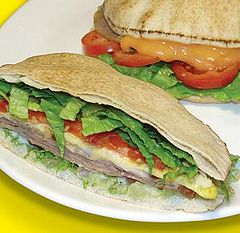Brazilian sandwich
.mw-parser-output .hidden-begin{box-sizing:border-box;width:100%;padding:5px;border:none;font-size:95%}.mw-parser-output .hidden-title{font-weight:bold;line-height:1.6;text-align:left}.mw-parser-output .hidden-content{text-align:left}You can help expand this article with text translated from
the corresponding article in Portuguese. (September 2019) Click [show] for important translation instructions.
View a machine-translated version of the Portuguese article.
Machine translation, like
DeepL or
Google Translate, is a useful starting point for translations, but translators must revise errors as necessary and confirm that the translation is accurate, rather than simply copy-pasting machine-translated text into the English Wikipedia.
Consider
adding a topic to this template: there are already 1,506 articles in the
main category, and specifying|topic= will aid in categorization.
Do not translate text that appears unreliable or low-quality. If possible, verify the text with references provided in the foreign-language article.
You must provide
copyright attribution in the
edit summary accompanying your translation by providing an
interlanguage link to the source of your translation. A model attribution edit summary is Content in this edit is translated from the existing Portuguese Wikipedia article at [[:pt:Beirute (sanduíche)]]; see its history for attribution.
You should also add the template ((Translated|pt|Beirute (sanduíche))) to the
talk page.
For more guidance, see
Wikipedia:Translation.
A Beirute is a Brazilian sandwich influenced by Syrian-Lebanese cuisine made with pita bread, brought to Brazil in the early twentieth century by Levantine immigrants. The Beirute sandwich uses two whole pieces of bread, not inside the pocket of a single piece of bread. The contents of Beirut can vary greatly, the most found ingredients are pita bread, roast beef or sliced silverside, or ham, cheese, lettuce, tomato slices and a fried egg.
The Beirut sandwich developed from the blending of cultural influences in cities like São Paulo.[1] The name Beirute is a reference to the capital of Lebanon, from where many Lebanese Brazilians migrated.[2]
The Beirute has similarities with other sandwiches in Brazil: The combination of ham and cheese exists in the misto-quente toasted sandwich, and ham or roast beef with cheese and tomato exists in the bauru. The combination of lettuce with tomato (and sometimes egg) also exists in some hamburger recipes.
This type of sandwich is found in various regions and cities of Brazil. Some cafeterias, as well as places that serve hamburgers, serve it with french fries and soda, an influence of American cuisine.
